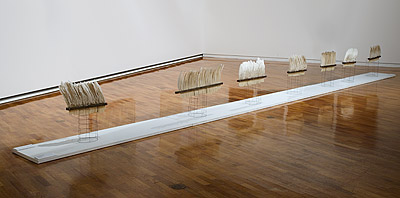Rosalie
GASCOIGNE
Aotearoa New Zealand
1917
–
Australia
1999
Australia from 1943
Feathered fence
1979
white swan feathers, galvanized wire netting, synthetic polymer paint on wood
64.0 (h)
x 750.0 (w)
x 45.0 (d)
cm
Gift of the artist 1994
National Gallery of Australia, Canberra
NGA 1994.256.A-R
© Rosalie Gascoigne. Licensed by VISCOPY, Australia
Rosalie Gascoigne played a significant role in redefining the Australian environment through her inventive application of found materials, to create a poetic vision of place. The combined strength and lightness of touch in her art emerges from her precise powers of observation and capacity to distil deeply-felt experiences of natural phenomena. These experiences came from living in the landscape, walking in the landscape, travelling through the landscape in a car. They came from finding multiple associations with old, worn materials that retain a sense of time and the effects of weather. They also came from chance encounters with seemingly ephemeral objects such as feathers.
While Gascoigne’s work relates to an Australian tradition of landscape, Feathered fence may also be defined in a wider context of land art and experimental art in the 1970s such as Christo and Jeanne-Claude’s Running fence 1972–74.[1] There are parallels between the linear nature of their fabric-covered Running fence, which traverses an actual landscape, and Gascoigne’s use of inventive materials to create a trajectory through space. Yet in practice Gascoigne was always intent on personal discovery, on constructing and re-assembling materials, getting to know their distinctive properties―such as the bend or obduracy of the quills and lightness of the softer feathers―to the point of being obsessed by them.
In the 1970s Gascoigne found much of her source material in the local tips. She recalled that in the course of one such visit, a New Zealand friend insisted they find a more congenial (less pungent) environment to have their lunch. They drove from the Bungendore tip to the south end of Lake George. The weather was warm and the black swans had been shedding white feathers from the underside of their wings. Gascoigne immediately knew she was on to something. For an artist who always had the capacity to see the great benefits of accumulating like materials, she loved the fact that there were lots and lots of feathers in the landscape. Before too long her home in Canberra was filled with white feathers. She began to experiment with the feathers in a range of ways, including threading them through newspaper to attain/evoke the feeling of the paleness of the landscape. In February 1978 she wrote to her son Martin: ‘Am involved with Lake George and a great feather investigation … Also horizontals, like lake water, and clean air and pallor.’[2] The idea of the landscape as pale, soft and open, took a distinctive turn in Feathered fence when she hit on the idea of elevating the feathers on galvanized wire netting used for fences. Above the open, airy bases, the densely packed feathers are held together in the slats of bee boxes.
Traditionally a fence suggests a demarcation, a dividing line between one space and another. When installed on its plinth in a gallery, the long line of Feathered fence necessitates walking along and around the work. We must pace ourselves. Yet as we walk and look and contemplate, we find that this is no ordinary fence but rather one that is quite open in its structure. In poetic ways the arc of the curved feathers suggests the swans’ capacity to defy gravity. Likewise, by its expansiveness, Gascoigne seems to be inviting us to bring our own personal responses to the Feathered fence―to allow our imaginations to take flight.
Deborah Hart
Senior Curator
Australian Painting and Sculpture post-1920
National Gallery of Australia
[1] Feathered fence was shown in the Biennale of Sydney in 1979. Although Rosalie Gascoigne was acting independently, she was aware of this work by Christo and Jeanne-Claude, and makes reference it in several letters to her son Martin Gascoigne
[2] Extract from the artist’s letter to Martin Gascoigne, 14 February 1978; sent to the author on 11 February 2009. These letters are from the Rosalie Gascoigne Archive, courtesy Martin Gascoigne, NGA Research Library

